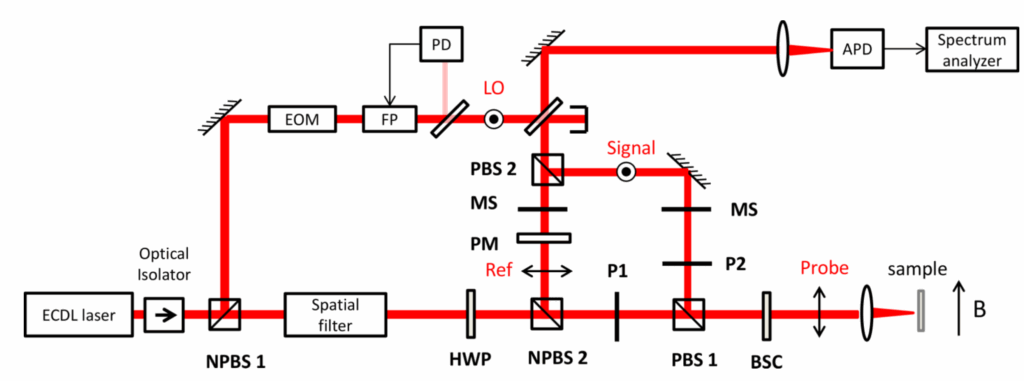Spin physics
This research theme is strongly based on the spin noise spectroscopy (SNS) technique, which allows us to probe the spin of electrons, nuclei, and magnetic ions (Mn²⁺), as well as their interactions, in semiconductors and their nanostructures.

Spin noise spectroscopy :
Spin noise spectroscopy (SNS) is a novel and versatile method for studying magnetic resonance and spin dynamics. It relies on measuring magnetization noise through the Faraday rotation technique.

We have contributed to the development of this technique by enhancing both its sensitivity and the accessible frequency range through a heterodyne detection scheme.
The SNS implemented at L2C enabled, in particular, the detection of atomic-like spin fluctuations of Mn ions diluted in CdTe, whereas SNS had previously been limited to carriers in semiconductor heterostructures.
More recently, we implemented spatiotemporal spin noise spectroscopy and applied it to n-CdTe, achieving spatial resolutions down to approximately ∼λ/10. This research benefits from a long-standing and fruitful collaboration with the Institut Néel.
Nuclear spin :

In a series of theoretical and experimental studies, we established the potential of SNS for probing the nuclear spin polaron, a collective electron–nuclear spin state specific to semiconductors. To this end, we investigated nuclear spin relaxation in both n- and p-type GaAs, experimentally and theoretically, as a function of impurity concentration and magnetic field (in collaboration with C2N and the SpinOptics Lab in St. Petersburg).
The adiabatic demagnetization of nuclei to zero magnetic field, detected by SNS, provided the first direct confirmation of the nuclear spin temperature hypothesis, as well as a direct measurement of the nuclear heat capacity. Subsequently, we proposed and implemented nuclear magnetic resonance experiments detected via electron spin noise.
These experiments allowed us to establish a link between residual strain in n-GaAs, which gives rise to quadrupole splittings, the increase in nuclear heat capacity, and nuclear spin relaxation rates at low and zero magnetic field.
Atomic spin in solids :
This has been demonstrated notably with manganese in cadmium telluride (CdTe:Mn), providing a model system for exploring spin physics at the atomic scale.

References :
- Review of Scientific Instruments, 2016, 87 (9), pp.093111. ⟨10.1063/1.4962863⟩ https://hal.science/L2C/hal-01397602v1
- Nature Communications, 2015, 6, pp.8121. ⟨10.1038/ncomms9121⟩ https://hal.science/L2C/hal-01216561v1
- Physical Review Letters, 2019, 123 (1), pp.017401. ⟨10.1103/PhysRevLett.123.017401⟩ https://hal.science/L2C/hal-02192421v1
- Physical Review B, 2022, 105 (15), pp.155305. ⟨10.1103/PhysRevB.105.155305⟩ https://hal.science/hal-03711870v1
- Physical Review B, 2021, 103 (20), pp.205207. ⟨10.1103/PhysRevB.103.205207⟩ https://hal.science/L2C/hal-03246864v1
- Phys. Rev. Research 7, 2025, pp. 013222. ⟨10.1103/PhysRevResearch.7.013222⟩
Recent theses :
- GRIBAKIN Boris (2021-2024)
Our funded projects on this theme :
- ANR CONUS
- Vernadsky Fellowship (French Embassy in the Russian Federation, 2021–2025, PhD co-supervision of Boris Gribakin)